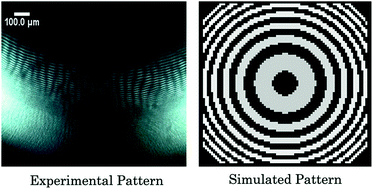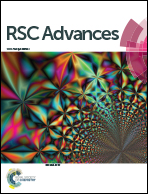Pattern formation of drying lyotropic liquid crystalline droplet†
Abstract
We present a study of pattern formation in drying sessile droplets of aqueous solutions of cetyltrimethylammonium bromide (CTAB)–water system using polarising optical microscopy (POM) and computer simulation. A 4-fold symmetrical and a 3 dimensional staircase like pattern appear during drying of the droplets of the CTAB–water system. However, when NaBr salt is added to the solution, the pattern changes to a system of concentric rings with a fainter set of hyperbolic fringes superimposed on it. The ring width is found to decrease from the central to the peripheral region. We compared the CTAB–water–NaBr pattern with patterns obtained by simulating a 3-dimensional model with various director configurations using a Jones matrix calculation. A good qualitative agreement of the simulated and experimental patterns is obtained for a model assuming a lenticular shaped droplet with the local directors parallel to each other and aligned horizontally, parallel to the fluid–substrate interface. The circular and hyperbolic fringe patterns as well as variation in width of rings are qualitatively reproduced by the simulation. When the droplet dries out completely dendritic crystals form for the CTAB–water droplet as well as the CTAB–water–NaBr droplet. Our results indicate that as the droplet concentration increases with evaporation, elongated cylindrical micelles form which prefer a mutually parallel, horizontal configuration.


 Please wait while we load your content...
Please wait while we load your content...